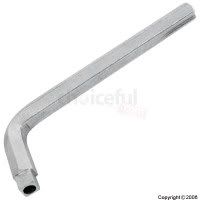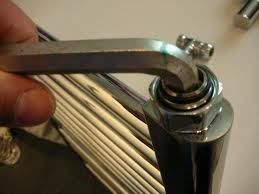A newbie question here...
I have some old rads with tails and valves that look extremely similar to what's shown in this photo: http://tinyurl.com/8aa9bvj i.e. there is a standard 15mm compression joint onto the pipe, but the connection to the radiator tail is rather larger, I think 3/4".
I want to replace these with TRVs (Screwfix item 32130, http://tinyurl.com/7se3e7p), that have the same 15mm compression connections onto the tail as they have onto the pipe. So they definitely won't work with the existing tails, but they are supplied with their own tails, and it looks like these new tails will fit the radiator.
So it looks like all should be fine provided that I can remove the old tails. The question is how. The radiators are old enough that it is likely to need some force. Although the new tails include a square nut section, the existing tails have only a circular outer diameter (again, just like the one shown in the first link).
A suggestion I've seen (if I understand it right) is as follows: tighten the tail's cap nut hard onto the valve, then remove the valve from the pipe, and then continue to turn the cap nut as if to tighten the tail onto the valve (except that the valve is now free to rotate) and this will undo the tail from the radiator.
It seems sensible, but: (a) will it work, and (b) is it non-destructive?
The reason I ask about nondestructive is that if it all goes wrong with the TRV (e.g. the spacings aren't right and there isn't enough give in the pipe) then I'd like to keep the option of putting everything back how it was. If I tighten that joint from the old tail onto the old valve enough to get enough grip on the tail to unscrew it from the rad, am I likely to damage the joint worse than can be fixed by fitting a new 3/4" olive?
Alternatively, is there any other way of getting the old tail off?
Many thanks.
I have some old rads with tails and valves that look extremely similar to what's shown in this photo: http://tinyurl.com/8aa9bvj i.e. there is a standard 15mm compression joint onto the pipe, but the connection to the radiator tail is rather larger, I think 3/4".
I want to replace these with TRVs (Screwfix item 32130, http://tinyurl.com/7se3e7p), that have the same 15mm compression connections onto the tail as they have onto the pipe. So they definitely won't work with the existing tails, but they are supplied with their own tails, and it looks like these new tails will fit the radiator.
So it looks like all should be fine provided that I can remove the old tails. The question is how. The radiators are old enough that it is likely to need some force. Although the new tails include a square nut section, the existing tails have only a circular outer diameter (again, just like the one shown in the first link).
A suggestion I've seen (if I understand it right) is as follows: tighten the tail's cap nut hard onto the valve, then remove the valve from the pipe, and then continue to turn the cap nut as if to tighten the tail onto the valve (except that the valve is now free to rotate) and this will undo the tail from the radiator.
It seems sensible, but: (a) will it work, and (b) is it non-destructive?
The reason I ask about nondestructive is that if it all goes wrong with the TRV (e.g. the spacings aren't right and there isn't enough give in the pipe) then I'd like to keep the option of putting everything back how it was. If I tighten that joint from the old tail onto the old valve enough to get enough grip on the tail to unscrew it from the rad, am I likely to damage the joint worse than can be fixed by fitting a new 3/4" olive?
Alternatively, is there any other way of getting the old tail off?
Many thanks.




